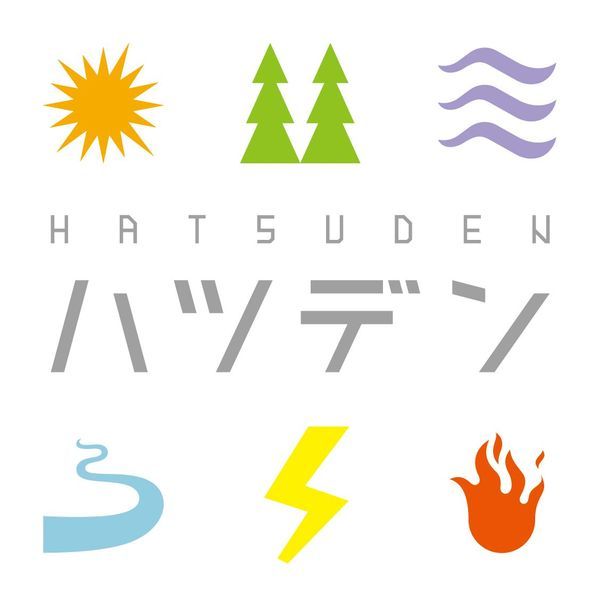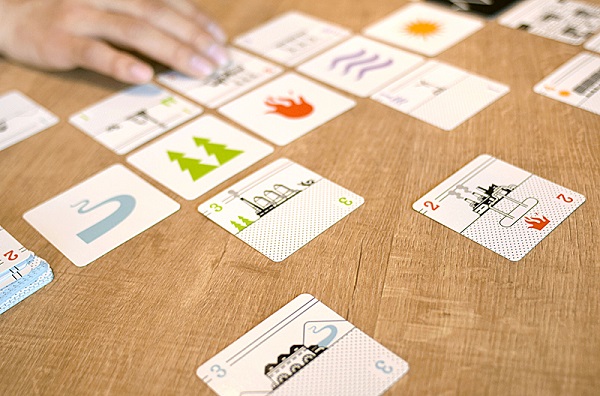Hatsuden: A Two Player Card Game of Balance and Power

Compete head-to-head in this two player card game about carefully balancing the value of the cards you play in order to maximize your points.
From Japanese company itten, Hatsuden is a small sized card game about competing for energy sources while also being careful not to overload your cities with too much power.
Gameplay
Five different energy cards are laid in a row in the center. Each player takes two city cards and places them on their side of the table. Each city card represents one of your two rows of cards, with each column in the two rows connected to one of the five energy cards.
The power plant cards are shuffled and each player is dealt five cards. Each power plant card is a color that corresponds to one of the five energy cards and a number one through four. There are two copies of each power plant card.
On your turn you may take one action. You may play one power plant card to an empty space in one of your two rows. You must play it to the space below the energy card whose color matches the plant card. Alternatively, you may upgrade a power plant card by playing a new power plant of a higher number on a plant card of a matching color. If you cannot or choose not to do either action, you may play a power plant card face-down on an empty space in one of your rows. This will be a pylon. Pylons are worth zero energy points and cannot be upgraded. If you choose to take none of these actions, then you must discard a card face-up.
If at any point during the game, all the numbers of your power plant cards in a single row equal twelve or higher, the city has too much power and you must flip over one or more power cards to their pylon side until the combined value is eleven or less.
To end your turn you draw a card from the draw deck or select one from the discard pile (note: from the rulebook it is not clear if you draw the top card from the trash or may select any).
There are four special technology cards that are set aside at the start of the game. Whenever someone plays a power plant card with a value of four, as long as there is a technology card remaining, he draws one and may use it at any point on one of his turns. Each one has a special ability. One is placed on an energy card to make it worth an extra point at the end of the game, one can be used to keep a power card you play secret, one allows you to downgrade a power plant card, and one can be used to increase the power limit of a city so that it is a value of thirteen that forces you to flip cards over to their pylon side.
The game ends once one player has a card in all ten spaces of their rows and the other player has had a final turn. Players earn one point for each city whose rows equal exactly ten points and loses one point for any city whose rows have a combined value of eight or less energy points. Each energy card is awarded to the player whose two cards in that card’s column have the highest combined value. Each energy card is worth one point. The player with the most points wins the game.

Review
Hatusden is a thoughtful little card game that provides each player with interesting elements to consider and weigh. How early do you want to play your big cards and which city row do you play them in? How do you keep each city’s energy level down to ten? How do you react to the cards your opponent chooses to play? There is plenty to consider there without making the game’s rules complicated or difficult to teach.
Players do have some information to work with, for instance exactly how many cards of each number and color are in the deck, so there is also some tracking of what has been played and what’s been discarded. As you near the end of the game, this can become particularly useful. Triggering the end game can also be an important choice.
The special technology cards add an extra twist to the gameplay that can make things a little bit more difficult to control or predict, and the card that keeps a power plant card value a secret is a particularly interesting mechanic.
Sometimes you can just have some really bad luck on what you draw. If you keep drawing lots of one’s, particularly near the end-game, or never get the opportunity to draw a technology card, this can stack the game pretty badly against you.
The rulebook is pretty well translated, and for the most part the gameplay is clear, however there are a few strange word choices and the rule on drawing from the discard pile is not clearly explained. Also, while a minor point, it would have been a nice touch if a translation of the game’s title was provided in the rulebook.
Hatsuden does have a nice minimalistic look to its artwork, the cards are a nice quality, and the game itself is quite compact and comes in a small box that is good for travel.
Turns are fast and the game is quick. It has nice back and forth interaction between the two players as they compete over each energy card. You can bluff a little with the ability to upgrade plants, and the two different scoring goals lead to some nice balancing requirements.
Pros: Components and artwork, need to balance row and column values, speed of game
Cons: Luck of the draw can be an issue, translation of the rulebook could be slightly improved
Disclosure: we received a complimentary review copy of this game.






